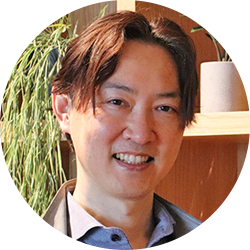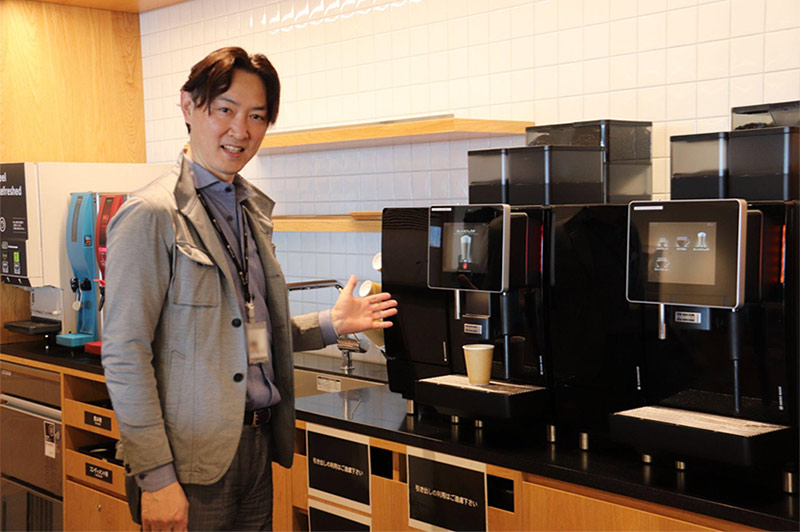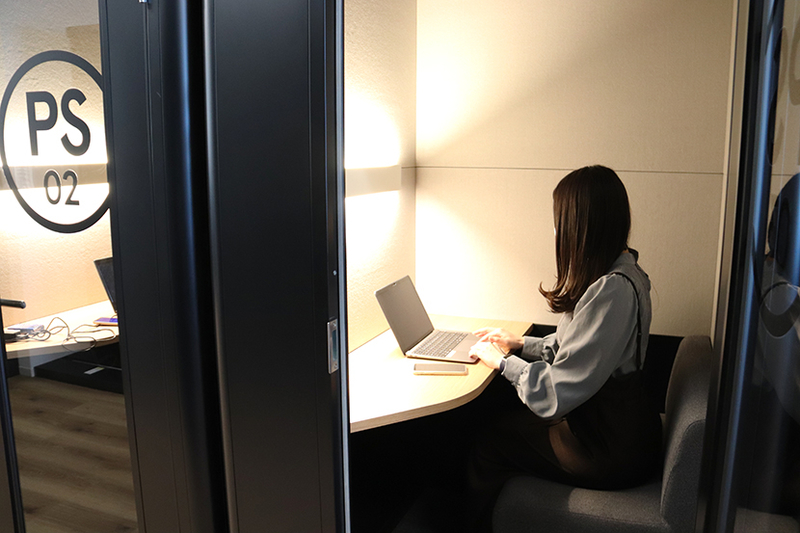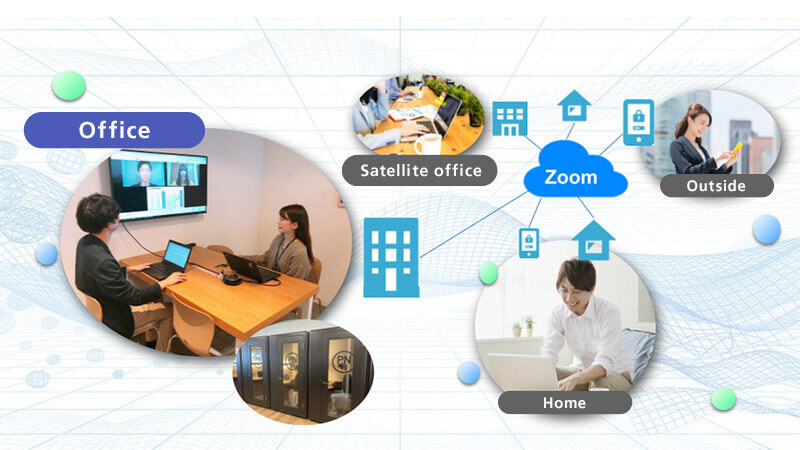
Approximately a year has passed since SoftBank Corp. (TOKYO: 9434) completed its relocation to its new headquarters in Tokyo Portcity Takeshiba, a state-of-the-art smart building. Over that time, the way SoftBank employees work has greatly changed due to COVID-19.
Takeshiba headquarters facilitates different modes of working
Nobuhide Sato, Director of the Group Office Strategy Department spoke about how employees based at Takeshiba headquarters are working and the challenges are they facing. Sato was involved with the relocation project and is also in charge of office strategy for SoftBank Corp. group companies.

Nobuhide Sato, Director of
Regional Administration Dept., General Affairs Service Div.; and
Group Office Strategy Dept., Group General Affairs Unit Office
General Affairs Div., Corporate Unit, SoftBank Corp.
Common area lounges invite chance encounters


Sato: With free coffee and tea, the common lounges on each floor are very popular. They’ve become spaces where everyone stops by several times a day to take a break. While I’m not going to the office currently due to COVID-19, when I did, I often saw employees who came in to work chatting with colleagues they ran into.
Sets of three floors are connected by staircases, and we intentionally installed espresso machines on the middle floors to attract people. I’m usually on the floor above the middle floor, so I often stop by other departments in the morning or after lunch to grab a cup of coffee. I believe it's quite common for significant projects to spring from small talk.
Office areas enable employees to focus on tasks

Sato: I use the hot-desk office area when I want to concentrate on my work tasks. When I need to have casual meetings, I sometimes hold informal discussions with my colleagues on the lounge sofas or at raised counters nearby.
We have only three printers per floor, which has an office space of 900 square meters. But this doesn’t seem to trouble anyone. I don't see many people using them (laughs). SoftBank led the way in going paperless, and with this relocation, we reduced the amount of stationery and physical objects in the office by 70%. Cabinet space per person has also been reduced. I feel this way of working without being tied down by physical things has really taken root.
Phone booths are optimal for remote meetings and calls

Sato: Employees use phone booths when they need a private room to make or take phone calls, or for when they attend online meetings. In addition to being convenient for conversations that are too intrusive for common spaces, the need for remote meetings with employees outside the office has increased, so we decided to add more phone booths after the relocation.
Employees choose the workplace that meets their objectives

Q: Why was this setup created in the first place?
Sato: Our headquarters is the main base for accelerating our "Beyond Carrier" growth strategy. To this end, we created a community-style workspace where all employees can perform at their best under SoftBank’s “Smart & Fun!” workstyle. In addition to fostering open innovation across departments, the Takeshiba headquarters was designed to facilitate a more innovative and creative way of working that is not bound by time, place or physical things.
In the past, employees mainly ferried between their desks and meeting rooms, but at Takeshiba, each employee can choose where to work depending on to the nature of what they need to do at any given time.
Q: There are other workplace options besides working at the Takeshiba headquarters, aren't there?
Sato: Yes, employees can work at home and from satellite offices, too. For example, if they have tasks that require a lot of concentration, they can work from home. If they have a meeting at a client’s office, they could go there directly and stop by a satellite office to complete tasks before returning home. Or if they want to generate new ideas, they could head to the office to brainstorm with their colleagues.
Q: How do you think these new ways of working have affected employees?
Sato: SoftBank has been introducing new ways of working for some time now. At first, some employees may not have been comfortable with the hot-desking system. And under COVID-19, except for a few employees who needed to come to the office for work, basically everyone has been working from home for a long time. Over this period, I think our employee mindset has changed a lot, as has the world. We’ve been blessed with the opportunity to incorporate more and more diverse ways of working and thinking, and the evolution of our workstyle has accelerated even more.
In fact, according to our recent Employee Satisfaction Survey, the score for "working environment" rose significantly. We’ve changed the working environment by incorporating various ideas with ingenuity, and this has led to a major change in employee mindsets.
Differentiating between "going to the office" and "working from home” will be key

Q: With some restrictions being lifted, more employees are using the Takeshiba headquarters and other facilities. What challenges does this present?
Sato: One is distinguishing between "coming into the office" and "working from home." The virtual way of working, where members can communicate online using various digital tools such as Zoom, without having to be in the same location, has taken root. Now that it has become more widespread, I believe that the importance of “real communication” will become even more important in the future.
Q: What do you mean by “real communication”?
Sato: Remote meetings are convenient and frequent because there’s no need to take time to get to or book a location, but I think the intensity of communication is different. We rely on our ears for a lot of information. With face-to-face communication, you receive more information, such as body language, facial expressions, and tone of voice. Also, it’s hard to interrupt a discussion politely during a web meeting.
Q: Many people have had that experience.
Sato: That's why I think it's very important to employ both "coming to work" and "working from home" as modes of working. We all want to come up with various ideas and create something new by bringing our thoughts together. In this case, I believe that real work, or going to the office, is optimal for this.

Q: An office is a place where innovation is born. Perhaps more people are realizing this.
Sato: That's exactly right. And an office is a place where team building is done. I feel that there is no problem in communicating remotely with members who already have established relationships. That said, I believe that real communication is the best way to build a relationship of trust with new employees and mid-career hires.
I feel that the significance of the office is changing. What’s the purpose of coming to the office? Taking this into account, we’ll identify a hybrid way of working that uses both "coming to work" and "working from home" to create new value while building trust among employees. This is what we’re aiming for as our next step, and I feel that my team needs to work on creating more mechanisms to achieve this.
Expanding the Takeshiba model to regional bases nationwide
Q: We've heard about the workplace centered on the Takeshiba headquarters, but will this style be expanded to other locations in Japan?
Sato: Yes. In the Tokyo area, we started consolidating and optimizing offices in fiscal 2020, mainly in two locations: the Takeshiba district for SoftBank Corp. and its Group companies and the Kioicho district for Z Holdings Corp. and its Group companies. This fiscal year, we’re also working with group companies to consolidate and optimize offices at regional bases.
Modeled after the Takeshiba head office, designs were created with the expectation that innovative conversations would take place as people gather, and the number of desks has been slimmed down by about 50%. To date, the project has been completed in eight regional cities and been very well received by employees. We’ll continue this initiative and plan to have it almost complete by the end of March 2022.
Q: What does the future hold for SoftBank workplaces?
Sato: Although the COVID-19 situation continues, WeWork Tokyo Port City Takeshiba—which promotes collaboration both inside and outside SoftBank—opened in the Takeshiba headquarters building in May 2021. A number of group companies and other organizations are moving into our building, and I expect that we’ll see co-creations there in the future. We’d also like to create more opportunities for collaboration among the employees of SoftBank Corp. group companies.
I believe SoftBank has made great progress in workstyle reforms over the past year. I’d like to drive this initiative further by combining it with a variety of new services to contribute to our corporation mission of making people happy through the Information Revolution.
(Posted on January 20, 2022; Original article posted on November 12, 2021)
by SoftBank News Editors


